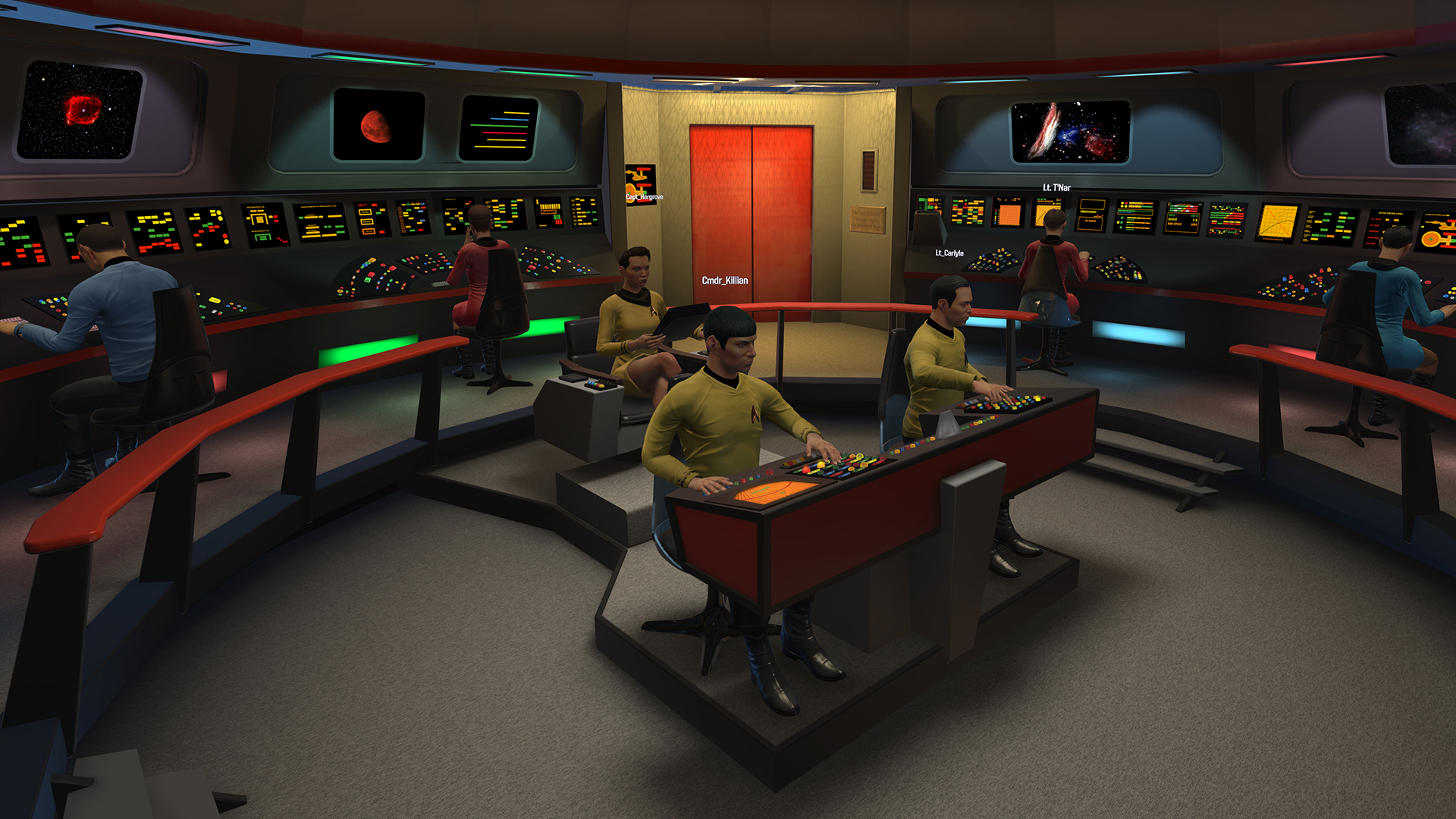Star Trek: Bridge Crew makes yelling at your space friends extremely rewarding
You'll just need three friends with VR headsets to play it.
My strongest memories of Star Trek are from my dad watch it nearly every day before dinner. I’m no series expert, but I do know this: it’s optimistic sci-fi about smart, diverse explorers slowly pressing out into the far reaches of space—and kissing, sometimes, probably.
I think about this while sitting at the helm station. I’m in a room with three other people, all wearing Oculus Rift headsets (it's playable on the Vive too) and wielding Touch controllers, playing Ubisoft’s Star Trek: Bridge crew, a cooperative game that focuses on Star Trek's most familiar settings: the ships. I’m steering the Enterprise through a minefield of dangerous space anomalies while a man I don’t know sitting in a chair behind me tells me to inch forward. I can’t figure out how to actually get the thrusters going because the controls are literally represented by a grid of multicolored square buttons with no way to intuit what they do. Another person I just met sits to my right at the tactical station, shouting out ‘Firing phasers!’ and popping the shield on and off so the person manning the engineering station can pump more power into thrusters. The captain cracks jokes and reminds me to keep the mines visible within the bay window.

None of us know what we’re doing, and that’s the primary thrust of Star Trek: Bridge Crew. Four people work together on different substations of a ship, moving it around dangerous anomalies, scanning for threats, and shunting power to different systems.
My dad would lose his shit if he could see this.
We’re in the Enterprise’s bridge, recreated down to the finest detail. Fine details in this case look like cheap plastic ice cubes and the cheaply carpeted everythings of '60s architecture. My dad would lose his shit if he could see this.
There are also other, more modern ships to pilot with more capable, clear interfaces (watch the video above to scope them out). But I had the most fun in Star Trek: Bridge Crew when I’m scrambling to do my job, to mash indiscriminate buttons expecting a positive outcome. There’s a button I can hold to highlight what each cheap jewel does—the bottom left quadrant is for steering, the upper right for engaging warp, and others strewn about for managing thrust and map interfaces—but I really like winging it. The more panicked we get, the more I struggle to achieve what the captain commands, the more it feels like I’m scraping by in a thrilling sci-fi explorer story. It’s incredibly cool, but you’ll need a group of friends, all with VR headsets and a copy of the game, to get much out of it.
Role play
Bridge Crew is broken up into a story mode with increasingly challenging missions and an endless mode that assembles random missions out of a few customizable variables. They’re not all combat focused, either. In one mission, we needed to sneak by Klingon patrols and transport people off of stranded frigates. In another, we just went on a space drive, scanning anomalies and ships for small tidbits of story.
Throughout it all, the Captain leads the crew, makes key decisions, and communicates objectives. They’re equipped with a suite of UI interfaces that give a general top-down perspective of the ship’s system status. Helm steers the ship and engages long range travel; Tactical operates scanners to identify enemy ships or anomalies, fires weapons, and control shields; and the Engineer manages power, repairs, and reports ship damage and repair status. Tactical and Helm also share the ability to hack subsystems on enemy ships and transport lifeforms from other ships to their own.
The biggest gaming news, reviews and hardware deals
Keep up to date with the most important stories and the best deals, as picked by the PC Gamer team.
Each role needs to accommodate another’s blind spots. Tactics might be able to scan and shoot at enemy ships, but phasers have a limited range so they depend on the Helm player to keep them within view. And the Helm player might need some extra power in the thrusters to do that, which means they’ll need to depend on Engineering to shunt power accordingly. And above it all, the Captain tracks all of the systems, keeping priorities in check. Maybe shunting power to thrusters is a bad call because it’s more useful somewhere else. Debating these priorities is half the fun, if you have the right crowd at hand.
A niche frontier
It’s possible to play the game alone with AI companions, but I wouldn’t want to. I can’t imagine there are many friend groups equipped with four VR headsets and a shared interest in Star Trek roleplaying, though. Even with online play, grouping up with strangers for such a buddy-buddy experience could be awkward and frustrating depending on who you land with. But VR headset owners and Star Trek fans tend to skew older, so chances are you won’t get angry 12 year olds barking orders while issuing profound takedowns of your mother.
With friends or people on the same wavelength, Bridge Crew has the potential to be one of the more engrossing social VR experiences yet. Juggling space chores in an involved, convincing setting is inherently silly and fun, especially when you navigate a particularly difficult challenge. I just hope there’s enough depth to test the most hardcore Star Trek and space chore fans.
During my four hour session with Star Trek: Bridge Crew, there wasn’t any mind-bending discovery or unbounding optimism and no kissing (damn!). There was a lot of goofing off and weird finger gestures and panicked yelling. We’re not professional space pilots with cool accents and trim jumpsuits, but Bridge Crew makes me want to be one. It comes out on the Oculus Store and Steam on May 30.
James is stuck in an endless loop, playing the Dark Souls games on repeat until Elden Ring and Silksong set him free. He's a truffle pig for indie horror and weird FPS games too, seeking out games that actively hurt to play. Otherwise he's wandering Austin, identifying mushrooms and doodling grackles.


